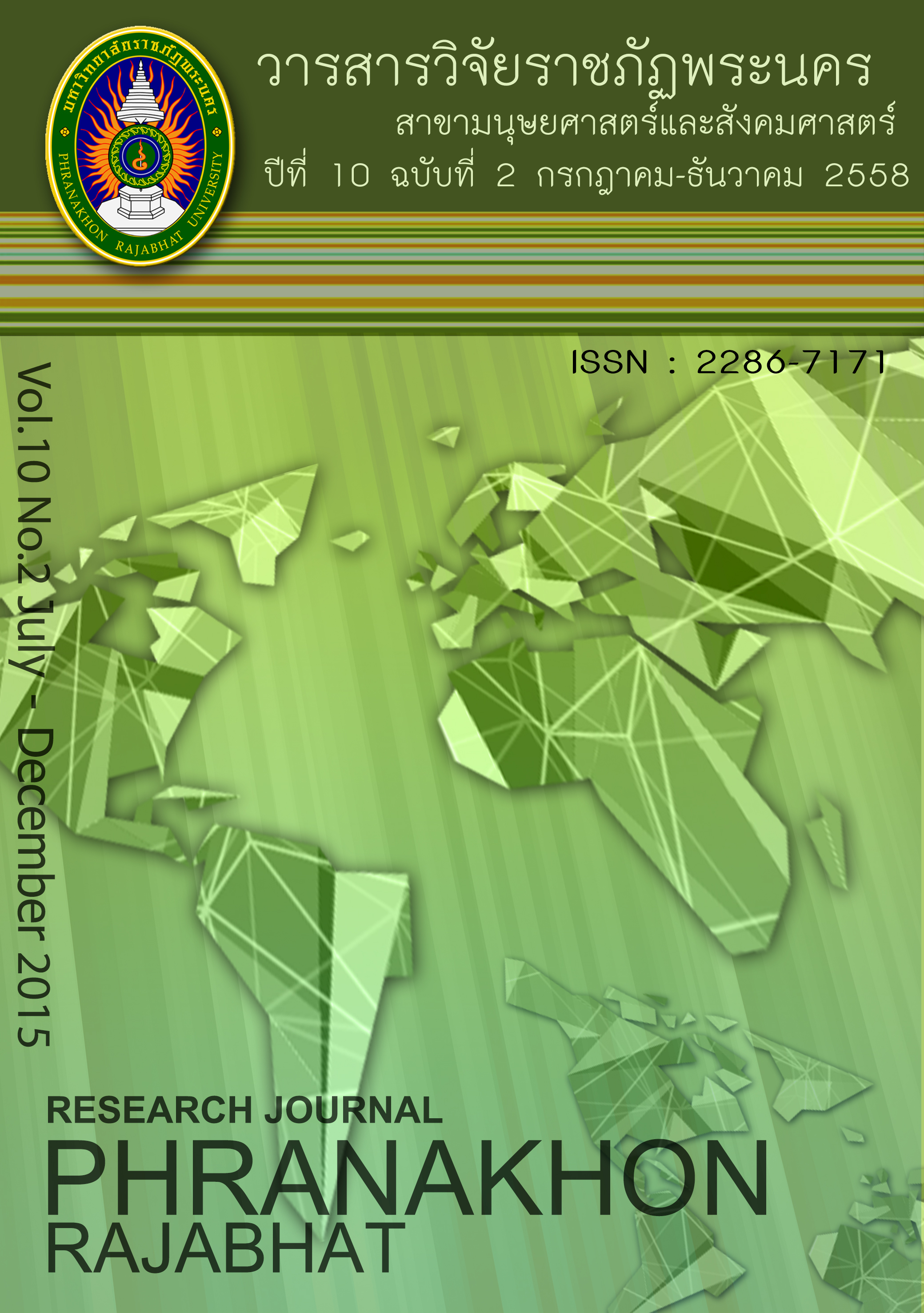การพัฒนารูปแบบกระบวนการมีส่วนร่วมของประชาชนในการจัดการ ทรัพยากรป่าไม้: กรณีศึกษาเขตป่าสงวนแห่งชาติ ตำบลทุ่งพระยา อำเภอสนามชัยเขต จังหวัดฉะเชิงเทรา
Main Article Content
Abstract
การวิจัยครั้งนี้มีวัตถุประสงค์ ดังนี้ 1) เพื่อศึกษาบริบทชุมชนการมีส่วนร่วมของประชาชนในการจัดการทรัพยากรป่าไม้ 2) เพื่อศึกษาสภาพปัญหาการมีส่วนร่วมของประชาชนในการจัดการทรัพยากรป่าไม้ 3) เพื่อพัฒนารูปแบบการมีส่วนร่วมของชุมชนในการจัดการทรัพยากรป่าไม้ 4) เพื่อเสนอแนะแนวทางการเสริมสร้างศักยภาพของชุมชนในการจัดการทรัพยากรป่าไม้ การวิจัยครั้งนี้มี 3 ขั้นตอน โดยขั้นตอนที่ 1 เป็นการเก็บรวบรวมข้อมูลเชิงปริมาณ ผู้วิจัยเก็บรวบรวมข้อมูลด้วยแบบสอบถามจากกลุ่มตัวอย่างจำนวน 400 คน ที่อาศัยอยู่ในพื้นที่เป้าหมาย 19 หมู่บ้าน ขั้นตอนที่ 2 เป็นการเก็บรวบรวมข้อมูลเชิงคุณภาพ ซึ่งได้มาจากการสัมภาษณ์เชิงลึก โดยมีชาวบ้าน หน่วยราชการท้องถิ่น และอาสาสมัคร เป็นผู้ให้ข้อมูลสำคัญ นอกจากนั้นผู้วิจัยยังได้ดำเนินการปฏิบัติการวิจัยแบบมีส่วนร่วม (PAR) ที่เน้นการจัดการความรู้ด้านการจัดการทรัพยากรป่าไม้ และมีกิจกรรมที่เกี่ยวข้องทุกฝ่าย มีส่วนร่วม และขั้นตอนที่ 3
ผู้วิจัยนำข้อมูลที่ได้มาสร้างรูปแบบและประเมินรูปแบบ ผลการวิจัยพบว่า: 1. บริบทชุมชน ประชาชนส่วนใหญ่ย้ายถิ่นฐานมาจากภาคอีสาน อยู่รวมกลุ่มกันแบบเครือญาติมีเอกลักษณ์โดดเด่นด้านภาษา ภูมิปัญญา วัฒนธรรม ประเพณีและความเชื่อ 2. สภาพปัญหาป่าไม้เขตป่าสงวนแห่งชาติ ตำบลทุ่งพระยา มีการตัดไม้ทำลายป่าเกิดจากความต้องการพื้นที่ทางการเกษตร การเผาป่าเพื่อล่าสัตว์ และไฟป่าที่เกิดขึ้นเองตามธรรมชาติ ประชาชนขาดการมีส่วนร่วมในการดูแลรักษาป่า ท้องถิ่นและภาครัฐขาดงบประมาณสนับสนุน 3. รูปแบบกระบวนการการมีส่วนร่วมของประชาชนในการจัดการทรัพยากรป่าไม้ ประกอบด้วย 5 มิติ ได้แก่ มิติที่ 1 การทำงานแบบ 3 ประสาน ประกอบด้วย นักวิชาการ ชุมชนท้องถิ่น เจ้าหน้าที่รัฐ มิติที่ 2 การมีส่วนร่วมในกิจกรรมการเรียนรู้ มิติที่ 3 การริเริ่มให้เกิดโครงการปฏิบัติจริง มิติที่ 4 การพัฒนาทางเศรษฐกิจ สังคม และสิ่งแวดล้อม มิติที่ 5 การพัฒนาให้เกิดสถาบันในชุมชน นอกจากนั้นองค์ประกอบของรูปแบบมี 7 องค์ประกอบ ได้แก่ 1) การค้นหาบุคคล/กลุ่มที่สนใจ 2) การจัดตั้งภาคีร่วมพัฒนา 3) การวางแผน 4) การดำเนินโครงการ 5) การตัดสินใจ 6) การประเมินผล 7) การร่วมรับผลประโยชน์ 4. แนวทางการพัฒนาศักยภาพของชุมชนในการจัดการทรัพยากรป่าไม้ คือ (1) การจัดตั้งคณะกรรมการอนุรักษ์ป่าไม้ (2) การพัฒนาศักยภาพการใช้ประโยชน์จากทรัพยากรป่าไม้อย่างยั่งยืน (3) การสร้างเครือข่ายองค์กรชุมชน
The purposes of this research were: 1) to study a community context in the management of forestry resource, 2) to study problem circumstances in the management of the forestry resource, 3) to develop a model of people participation in the forestry resource management, and 4) to propose the direction for the development of the community capability on the management of forestry resource. The 3 steps of doing this research were: 1) the researcher collected quantitative data by using a questionnaire; the samples consisted of 400 persons from the target area, i.e. 19 villages, 2) the researcher collected qualitative data by means of in-depth interview which villagers, local government agencies, and volunteers were key informants. Apart form that, the researcher proceeded a participatory action research (PAR) focused on knowledge in forestry resource management, and 3) the researcher developed a model of people participation process on the forestry resource management based on the collected data.
The findings of this research revealed that:1. Related to the community context, most people migrated from the north easternpart of Thailand. They lived together as a cluster of families or relatives. Their distinguishidentities were mainly in the aspect of language, local wisdom, tradition and belief.2. Related to the problem circumstances of TambonThungphraya National Preserved Forest Area: the deforestation in this area caused by the people, who needfor agricultural land, bush fi ring for hunting, including natural bush fi re, lacking of peopleparticipation in the forestry management, and lacking of supporting budget from localand government agencies.3. The model of the people participation in the management of forestry resourceconsisted of 5 aspects, i.e. (1) coordinated working between three parties namely;academics people living in the community, and government officials; (2) participation inlearning activities; (3) creation of practicum programs; (4) economical, social andenvironmental development; and (5) development aiming at the creation of communityinstitutes.Apart from that, the model also consisted of 7 factors as follows: (1) lookingfor interested persons/groups, (2) organizing of the participatory development alliance,(3) planning, (4) project proceeding, 5) making decision, (6) evaluation, and (7) sharingbenefits.4. The direction for the development of the community capacity in the managementof the forestry resource were as follows: (1) the organizing of the forestry preservationboard (2) the capability development on sustainable forestry resource utilization, and(3) the organizing of community organization connection.
Article Details
Each publish articles were copyright by Phranakorn Rajabhat University
Any contents which appeared in each articles in the journal were authors personal opinion. It did not relate to Phranakorn Rajabhat University and other instructors in the university. Each authors would take responsibility on their articles. If there are any mistake, the authors will take responsibility themselves


